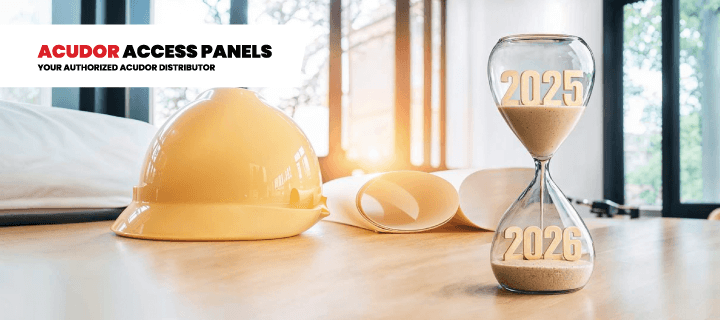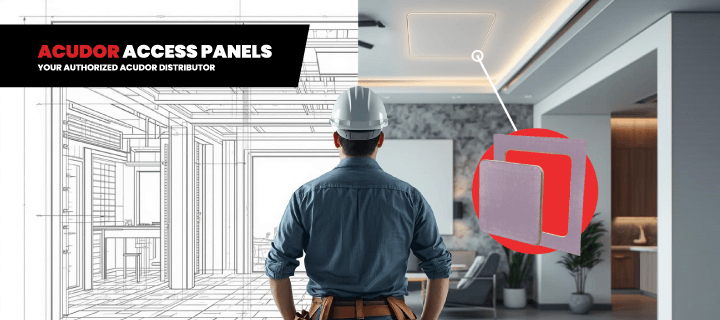What Are the Best Insulated Access Panels for Energy Efficiency & LEED Points in Commercial Projects? Posted by Acudor Access Panels on 13th Oct 2025
Access panels that promote energy efficiency and contribute to LEED points are durable, insulated, and air-tight. They reduce heat loss and limit air leakage, contributing to a building's envelope performance.
When access panels fail to meet energy efficiency standards, contractors risk expensive rework late in the project, or worse, losing LEED credits. Poor insulation and uncontrolled air leakage also mean higher HVAC costs down the road.
Panels like the FW-5050 and FW-5050-UP go further to combine energy-efficiency features with fire-rated compliance. This way, project teams don't have to choose between sustainability and fire performance.
This article explains what makes an access panel energy-efficient, and how fire-rated, insulated models contribute to LEED strategies.
What Makes an Access Panel Energy-Efficient?
An energy-efficient access panel minimizes heat transfer and air leakage through a high-R insulated core, an effective thermal break, and gasketing that seals under load. Let's break it down:
Insulated Core
An access panel's insulated core (made from mineral wool, fiberglass, etc.) slows down the flow of heat. It’s typically expressed as an R-value (resistance to heat flow) or U-factor (the inverse, measuring how easily heat passes through).
The rule of thumb is that a higher R-value or lower U-factor equals better performance. A panel with a strong, insulated core helps keep indoor spaces stable, which reduces the load on HVAC systems and ultimately cuts long-term operating costs.
Continuous Thermal Break
Thermal bridging can undermine even the best insulation. This refers to the direct transfer of heat through metal components. In access panels, this often happens at the frame, where metal-to-metal contact creates a path for heat to bypass the insulated core.
A continuous thermal break solves the problem by inserting a material with low thermal conductivity between the interior and exterior metal surfaces. You may see condensation, drafts, or cold spots without the break. With it, you preserve the panel’s thermal rating and keep your envelope design performing as intended.
Seals and Gaskets
Insulation and thermal breaks will not help if the panel leaks air around the edges. That’s where seals and gaskets come in. A quality gasket compresses when the panel closes, creating a tight seal that resists air movement.
Uncontrolled air leakage can account for a surprising share of energy loss in commercial buildings. The difference between a tight panel and a leaky one shows up quickly in HVAC performance—a tighter seal results in less energy loss.
That’s also why standard sizes don’t always cut it. To maintain envelope performance, access panels must match the specific wall or ceiling conditions where they’re installed. At Acudor Access Panels, we provide customization options for unique project specs. Explore custom sizes to ensure a precise fit for your project, every time.
Can Fire-Rated Insulated Panels Help Projects Qualify for LEED?
Fire-rated insulated access doors often make a strong case for LEED-qualified performance. For one, they have built-in insulation and tight seals, which resist heat transfer and air leakage.
Secondly, they offer dual compliance. So instead of juggling one product for insulation and another for fire-rating, these panels give you both in one. This minimizes substitutions, saves time, and avoids rework later in the project.
Finally, fire-rated insulated access panels provide spec-friendly documentation. That means you’ll need to supply specifications for energy modeling and air leakage numbers to demonstrate better envelope tightness.
Because fire-rated access doors already undergo rigorous testing, manufacturers tend to publish clearer, more complete technical data. It makes it easier for contractors, architects, and energy modelers to include them in specs confidently.
In other words, picking products with documentation that supports LEED workflow helps avoid last-minute substitutions that kill points.
Related: How Can Code-Compliant Access Panels Help Commercial Projects Pass Inspection Without Delays?
How Do Fire-Rated Insulated Panels Compare to Other Insulated Models?
Quality fire-rated insulated access panels deliver both thermal insulation and UL-listed fire resistance. Many generic insulated models prioritize the former. Another point to note is that standard commercial insulated access doors may have decent cores but can lack a thermal break or tested air leakage numbers.
On the other hand, some fire-rated panels have a UL certification but feature minimal insulation.
Well-designed fire-rated insulated models bridge that gap by pairing an insulated core with frame details that limit thermal bridging and a gasket system that reduces air leakage.
Here’s a concise comparison:
| Type | Features |
|---|---|
| Generic Insulated |
|
| Fire-Rated Only |
|
| Fire-Rated Insulated |
|
LEED energy credits often reward true envelope performance. Fire-rated insulated models like the FW-5050 variations help support these goals without trading fire compliance.
Related: Designing Commercial Spaces: How To Integrate Access Panels for Efficiency and Code Compliance
What Makes FW-5050 and FW-5050-UP Stand Out?
The FW-5050 series (including the FW-5050-UP variant) provides thermal insulation and fire resistance, helping contractors meet energy and code requirements without compromise. Both products feature:
- Durable construction featuring a steel panel and mounting frame.
- 2" thick fire-rated insulation for thermal performance.
- A universal self-latching bolt so the door stays securely shut.
- A concealed hinge and a prime coat finish for aesthetics
- The option for either a steel or stainless-steel finish.
The FW-5050-UP differs from the FW-5050 in that the FW-5050-UP is an inward-opening access door rated for ceilings. It has a 1-hour rating in combustible ceilings and a 3-hour rating in non-combustible ceilings.
The FW-5050 is rated for both walls and ceilings with a 1-1/2 hour B Label UL rating for walls and a 3-hour rating for ceilings.
Ready to balance compliance, energy efficiency, and clear documentation? Request a project-specific quote today or explore our product page for full details.
Frequently Asked Questions About Insulated LEED Panels
1. What is LEED energy efficiency?
LEED energy efficiency refers to strategies that reduce a building’s overall energy use as measured in the LEED rating system. Instead of rewarding individual products, LEED examines how design choices (insulation, air sealing, HVAC, and lighting) combine to lower energy demand.
2. What role does insulation play in energy efficiency within green architecture?
Insulation slows heat transfer, helping buildings stay warm in winter and cool in summer with less energy input. In green architecture, this reduces HVAC loads, lowers emissions, and supports envelope performance goals central to LEED certification.
3. How do I choose the right LEED-qualified access panel?
Pick access panels with tested R-values or U-factors, verified air leakage ratings, and clear UL fire listings. Products backed by third-party data can be credibly included in energy models and submittals, helping projects meet LEED targets without delays or substitutions.
4. How do insulated access doors reduce HVAC loads?
Insulated access doors reduce thermal transfer (better R-value/U-factor) and minimize uncontrolled air leakage, which lowers heating and cooling demand. That means less runtime for fans and chillers. The result is measurable energy savings over the building’s life.
5. What’s the difference between FW-5050 and FW-5050-UP?
The FW-5050-UP is an inward-opening access door rated for ceilings with a 1-hour rating in combustible ceilings and a 3-hour rating in non-combustible ceilings. The FW-5050, on the other hand, is rated for both walls and ceilings with a 1-1/2-hour B Label UL rating for walls and a 3-hour rating for ceilings.
Conclusion
If you want to avoid compromising between compliance and energy efficiency, spec commercial insulated access doors that are UL-listed and have verified thermal performance. The FW-5050 and FW-5050-UP strike this balance.
Choosing the right panel up front saves time and money. It means fewer RFIs, smoother LEED submissions, and lower long-term operating costs. That means your team spends less time coordinating fixes and more time delivering projects on schedule.
If you’re ready to lock performance into your specs and move past the guesswork, take these next steps. Contact us for a project consultation or call us directly at +18886174472 if you have questions.
Acudor Access Panels is a trusted and authorized distributor of Acudor products. We proudly bring you their full range of industry-leading access doors and panels.





